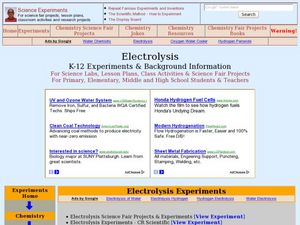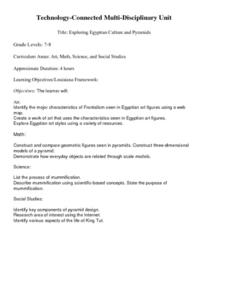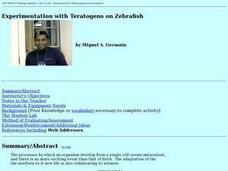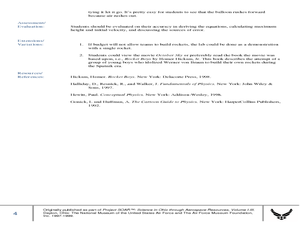Curated OER
Gathering, Traditions, and Nutrition of Our Food
Students gain a better understanding of what it means to eat seasonally through learning about traditional hunting, gathering, and food preparation methods of Athabascan tribes. By interacting with Native American Elders and...
Curated OER
Electrolysis
Young scholars conduct a series of experiments on water electrolysis. For this chemistry lesson, students explain what happens to the molecules during the process. They cite real world applications of electrolysis.
Curated OER
Exploring Egyptian Culture and Pyramids
Students access a variety of Egyptian Culture and pyramid related resources on the Internet. They explore various websites, read articles, create an Egyptian art figure, construct a model of a pyramid, and describe the mummification...
Curated OER
Collecting Leaves with Lewis and Clark
Fourth graders collect data on leaves collected, observe different species of leaves, and implement different methods of leaf preservation.
Curated OER
How do new species form?
Tenth graders conduct a critical analysis of current evolutionary concepts. They describe how scientists continue to investigate theories. Students examine examples with experimental data that suggest alternative methods of species...
Kenan Fellows
Determining Stream Health by the Diversity and Types of Benthic Organisms
How diverse are the benthic organisms found in local streams? Using the information learned in previous lessons on identification of macroinvertebrates and on calculating stream index values, groups determine the health of local...
NASA
Connecting Models and Critical Questions
Scholars use data to analyze and determine which sets of information need to be counted. They create a model to explain differences among chemical elements using graphs to prove concept mastery.
Curated OER
Experimentation with Teratogens on Zebrafish
Students compare mitosis and meiosis with regard to chromosome number in parent cells versus daughter cells, types of cells produced, total number of cells produced, and the number of divisions. In groups, identify and differentiate the...
Curated OER
Color My World
Students identify colors created by mixing primary colors and describe the process. They then design a book using the colors of a given season entitled "Colors of the Season".
Curated OER
Pill Bug Extravaganza
Tenth graders watch a PowerPoint presentation to review the scientific process. They examine pill bugs before designing an experiment to find new discoveries about these Crustaceans. They complete ten lessons in this unit.
Curated OER
Nutrition in Space
Students compare and contrast the process of dehydration with the processes of freezing and canning. They predict energy sources that may be accessible in the future in different environments such as the moon and planets, most notably Mars.
Curated OER
Inquiring Minds Want To Know
Eighth graders conduct a scientific experiment that help them explain the concept of nature versus nurture.
Curated OER
Measuring Where We Sit In The Universe
Students investigate scientific measurement. They use a variety of scales to do the job and communicate the results correctly. The teacher uses socratic questioning throughout the lesson checking for comprehension. Students measure some...
Curated OER
Heredity: Your Connection To The Past
Young scholars investigate genetics and the process of reproduction in living organisms.
Curated OER
What Influences Reaction Rate?
Middle schoolers study reaction rates, what determines how fast a reaction happens and how the chemical changes occur. In this reactions lesson students complete a lab where they use Alka-Seltzer to observe reaction rate and create...
Curated OER
Scientific Inquiry: Periodic Motion
Young scholars construct their own pendulum. In this physics lesson, students design an experiment to find the factors affecting its period. They formulate a conclusion based on experimental data.
Curated OER
Bird Populations
Students gather data about bird populations. They study bird migratory patterns using the methods that researchers use. They write an essay explaining the differences between the four types of population movements.
Curated OER
Rockets: Kinematics or Energy?
Students construct model rockets, measure and record the height of the launch. In this creative lesson students use different methods to calculate velocity and height data from their launched rockets.
Curated OER
Science Inquiry Lesson: Mapping Project
Pupils explore the methods of creating maps. They create a map of Animas River Park using a compass and measuring tape, develop a single map from the team map sections, and devise another map of the Animas River Park using a GPS unit.
Curated OER
Eratosthenes And Radius of the Earth
Students calculate the radius of the earth. They use the method and data suggested by Eratosthenes. They investigate the interrelationships among mass, distance, force, and time through experimental processes.
Curated OER
Deep Freeze
Students practice various sampling methods for retrieving data under water, ice, and soil. They use the sample material to make temperature measurements, chart contents, and draw their own conclusions as to what is happening in the...
Curated OER
Biomedical Imaging
Students use guided questions and research to compare two biomedical imaging methods. they effectively present their findings to the class. Students use new technical knowledge to summarize and compare new techniques with those they...
Curated OER
Half Life Lab
Seventh graders model radioactive decay using pennies, collect data from their model, apply scientific visualization techniques to their data and create animated models explaining the concept of radioactive half-life.
Curated OER
Science: Handwritten Personality
Young scholars watch an episode of "Frontiers" and discover the scientific basis for handwriting analysis. In the video, they discover how size, shape, and slant of handwriting suggest personality traits. After a discussion, students...























